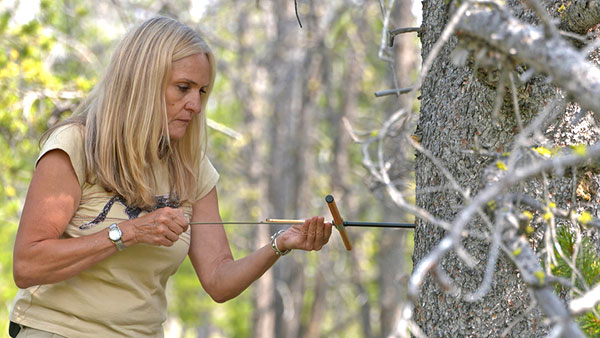Alum Features UM Whitebark Research in MontanaPBS Film

MISSOULA – As whitebark pine across the West rapidly die from a fungus, beetles and human-altered fire landscapes – all accelerated by a changing climate – a new film on MontanaPBS gives viewers a flicker of hope for the survival of this iconic tree species.
“Ghost Forests,” produced by University of Montana journalism alumna Breanna McCabe, premieres at 7 p.m. Thursday, Feb. 18, on MontanaPBS and online at http://montanapbs.org/ghostforests.
McCabe, a 2020 graduate of UM’s Environmental Science and Natural Resource Journalism Program, takes viewers into the high country of the Rocky Mountains in Montana and Canada to the elevations where whitebark pine grow. The tree is known as a “keystone species” essential to the survival of a number of animals, including grizzly bears that depend on its seeds for food. McCabe introduces viewers to the tree’s killers, and also, some of its saviors, including UM Professor Diana Six, a forest entomologist.
“Diana Six’s research sparked this entire project,” McCabe said. “I was entirely unfamiliar with the whitebark pine and its coolness factor before she told me about her latest discovery.”
McCabe’s journalism adviser, Nadia White, had seated her at a table with Six at the annual Crown Reporting Project dinner, a UM School of Journalism event. Each student has an end-of-dinner deadline to stand up and pitch an environmental story from their table for the chance to earn a fellowship to tell the story.
“I was fascinated when Six told me that she found some trees show genetic resistance to mountain pine beetle attacks,” McCabe said, “but, it turns out, that’s not all whitebark are up against. The more I learned, the bigger the story became.”
Forest managers across the west have long tried to stop the spread of white pine blister rust, an exotic disease humans introduced in North America around 1910. The airborne fungus attacks five-needle pines, including whitebark. Between mountain pine beetle attacks and blister rust, scientists estimate we’ve lost 60% to 80% of whitebark pine across its range, which stretches from western Canada to the Sierra Nevada range.
“It was alarming for me to realize just how precarious of a position the tree is in,” McCabe said. “Especially after I’d just learned about how important whitebark is, not only to the ecosystem, but for humans, too.”
McCabe takes viewers to one of Six’s study sites in southwest Montana and to three mountaintops in Canada’s Yoho and Kootenay national parks. Parks Canada resource managers climb promisingly resistant trees to collect the cones to propagate into seedlings. But it’s a slow process – it takes five years before they have results. And in the film, they admit they won’t see the results of their labor.
“These forests are turning into ghost forests before our eyes,” McCabe said.
In addition to the Feb. 18 premiere, MontanaPBS will broadcast “Ghost Forests” at 10:30 a.m. Sunday, Feb. 21, and 2:30 a.m. Monday, Feb. 22. To watch a preview of the film, visit http://www.montanapbs.org/ghostforests.
###
Contact: Breanna McCabe, producer, MontanaPBS, 406-243-4853, breanna@montanapbs.org.